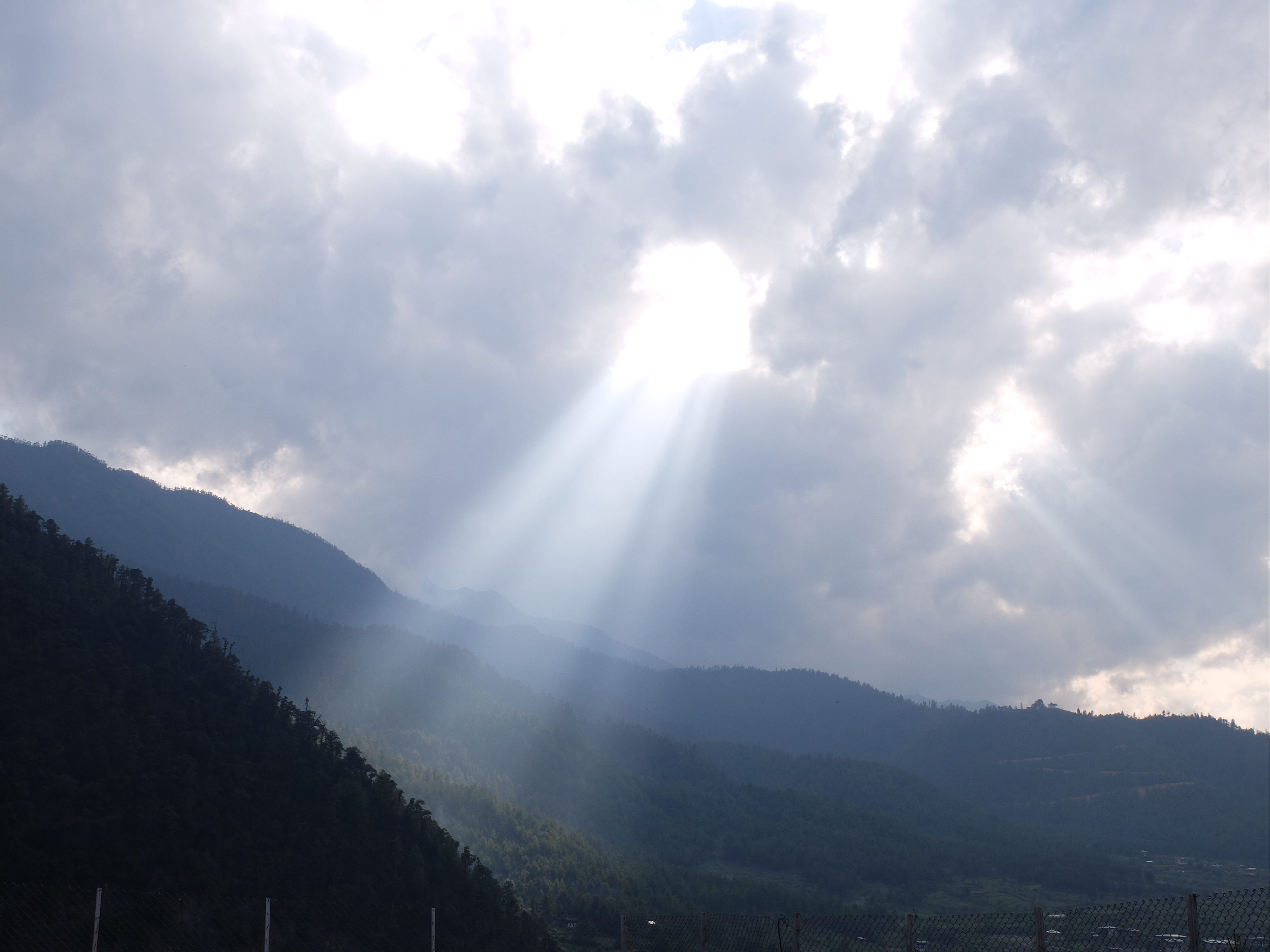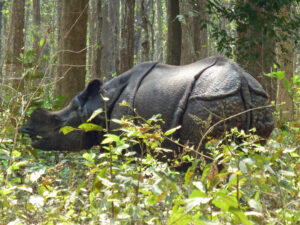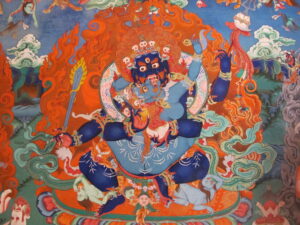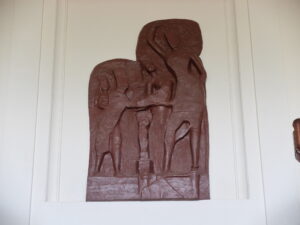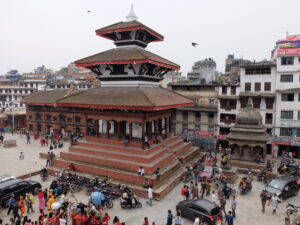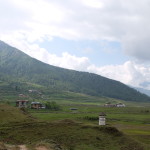
Mostly you notice the natural beauty. Driving the roads and trekking the trails across Bhutan, we traced the bulges and hollows of the richly forested mountain sides.

We ascended and descended steeply sloped valleys one to two kilometers deep. We padded across broad valleys as wide as the others were tall, with ranges of blue hills evaporating in the distance. Those valleys were quilted with cropland – swatches of rice, barley, potatoes.
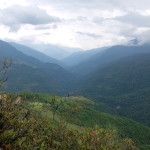
It’s all so improbably and diversely beautiful that one is tempted to think of Bhutan as Shangri-La, that mythical paradise on earth. Or perhaps as the storybook Lerner & Loewe Camelot, where the rules suit the good life and make it the most “congenial spot for happy ever-aftering.” For example, the law says you may not hunt and fish in Bhutan, let alone kill animals here, an extension of Buddhist kinship with them. The people do accept that eating meat is OK, but they must import it from India or elsewhere.
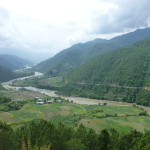
Size counts in making the country a pleasure – or rather the lack of size. Unlike the overwhelming numbers of say India or China, everything is small and manageable in Bhutan. The whole population is only about 750,000 in a territory a bit bigger than Maryland with just one-eighth of that state’s population. The worst traffic we saw was the “rush hour” movement of just a few dozen cars through a roundabout on the way out of the Thimphu Dzong governmental offices.
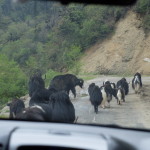
The only slowdowns are the raggedy mountain roads at higher elevations or side roads with cattle ranging down the lanes.
Natural beauty and quietude aside, the most Camelot-like aspect of Bhutan is its weighing the value of governmental and communal actions by their contribution to Gross National Happiness (GNH).
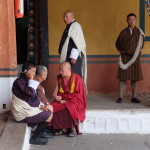
This measure, instituted over 40 years ago by the 4th modern king of Bhutan, Jigme Singye Wangchuck, replaced more traditional measures like economists’ favorites of GNP or GDP. The measuring is in the hands of one of the governmental departments, which also tries to increase happiness. You can only imagine the paperwork.
The fourth king was a bit unusual in other respects. In 2006, he abdicated his crown in favor of his son. He retained his five wives, who were all sisters we were told and collectively bore 10 children for him. The Bhutanese loved him and his son so much that they resisted the constitutional democracy he wanted for them. They got it anyway, along with the now more ceremonial monarchy the fourth king left in place.
In the ubiquitous portraits of father and son, the fourth king seems pretty happy himself. In his late 60s at this point, he mountain-bikes up and down the hills among his people. His successor still resides at the small palaces near the governmental seats of the dzongs, the holy fortresses (click here to read the article on dzongs). He often plays football with his subjects. But in the portraits he seems more stolid, typically with a movie star pose…and oddly is always looking to his left, often together with his one and only wife.
Though the country aspires to the best that humans can be, and clearly does things a bit differently, Bhutan is not a Shangri-La or Camelot.
Take, for example, the four pillars of GNH – culture and tradition; environment; good governance; sustainable socio-economic development.
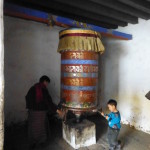
Culture and tradition – As a Buddhist society, fervent devotion is the norm. So much money and effort goes into preserving the historic temples from the 7th century, the dzongs from the 17th and earlier, as well as highlighting in museums the national culture (as with the revamped ancient watchtower in Paro).
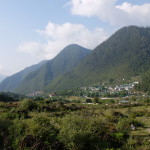
But the less touristy valleys like Haa to the west or those to the east don’t see the same kind of investment. They’re noticeably less privileged as in the quality of their roads.
Environment – To preserve and expand the 72% of the land that is covered with forest, Bhutan has instituted strict allocations of timber harvesting and also required replanting.
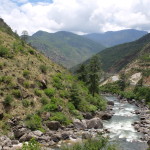
You have to take this on faith as we saw large lumberyards of logs and boards in the villages and not much sign of replanting. Meanwhile, with its fast flowing rivers, Bhutan’s largest export is hydro power to the power-hungry residents of India. However, the dams required are already adversely affecting the riverways.
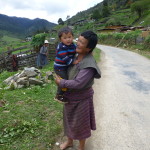
To make matters worse, improving the dangerous mountain roads in the middle of the country has led to scraping tons of rock and dirt from above the road, which then tumbles into the river beds below. At least, as we discovered from a chance meeting with some advisors from the World Wildlife Fund, the Bhutanese are now getting advice on the least injurious methods to generate power.
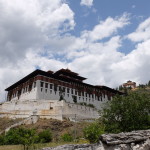
Good governance – The fourth king has been the role model, yielding power for the good of his people, as he saw it. But the bureaucracy is not apparently serving the country so well. In our short visit, we heard numerous popular tales of corruption at all levels. There was the district governor who funneled money to himself and his cronies, money intended for building a monastery at the sacred White Temple in Paro. There’s plenty of agreement that this kind of behavior is sadly common.
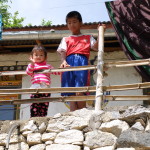
After the 2015 earthquake, aid organizations advisedly bypassed government officials and delivered support directly instead of watching fistfuls of money diverted into less needy hands. At least now, people said, there is now a new anti-corruption tsar, of whom good things are expected. Time will tell.
Sustainable socio-economic development – Hydro power expansion puts a strain on this pillar of course. And, in the south far from the largest cities and the tourist track, the government aims to expand manufacturing, such as the fairly new cement plant we heard about.
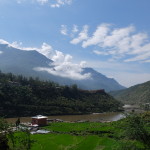
The main problem however is lack of jobs for the educated outside of hydro-power, government offices and tourism. Like many other emerging countries, the labor-intensive work of farming is losing favor with the young. They want something different, usually in the cities.
But tourism is controlled, and will likely remain so, keeping those job numbers low. For now, Bhutan handles tourism much differently than other countries do. For most visitors, Bhutan effectively acts as an all-inclusive national resort. If you’re not from neighboring India, typically Delhi or Kolkata, you pay a minimum of USD $250 per person per day for a package of hotel, food, guide and driver (though personal expenses and alcohol are extra) – no matter where you go within the country. It’s like a tax on touring.
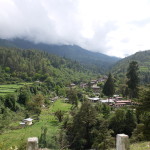
Chinese visitors are increasing, putting Mandarin-speaking guides in a lucrative position and kicking up demand for busses to transport them. But, for now anyway, the numbers of tourists remain low, while value of each visitor to the economy is high.
Bhutan’s policies help minimize the ill effects that hordes of tourists bring (hotel development, traffic, road use, wear and tear on the ancient monuments, etc.). Yet they do limit the potential jobs in catering to visitors.
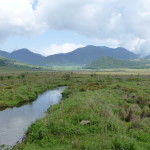
Perhaps the lack of jobs explains why Gross National Happiness is not as high as you might expect, according to some studies we saw in the papers. Nonetheless, the country is working hard to put resources toward increases in happiness, including improving Bhutan’s social safety net of free healthcare and education.
The Bhutanese seemed reasonably happy to us and the country remains a very happy place to visit in the minds of outsiders. The foreigners we met were uniformly pleased with the value of their trips.
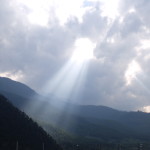
Also, the country is on a lot of bucket lists we’ve seen – whether for its embracing Buddhist philosophy, the hospitality of its people, the rapture of its lush landscape, its historical treasures, its aspirations to national happiness, or even its price-fixing of tourism.
Though it might not yet be Shangri-La or even Camelot, experiencing these pleasures in Bhutan – and breathing the lesser oxygen of its high mountain valleys – can make you think it’s truly a paradise after all.
(Also, for more pictures from Nepal, Tibet and Bhutan, CLICK HERE to view the slideshow at the end of the Nepal-Tibet-Bhutan itinerary page.)


